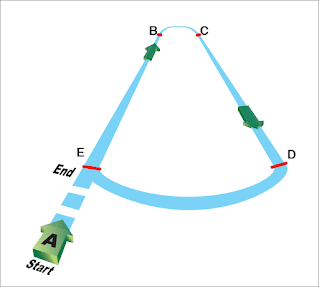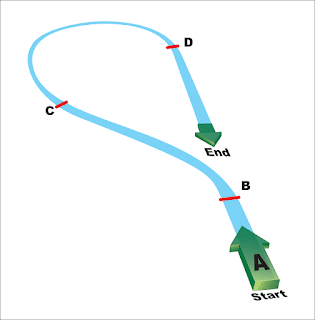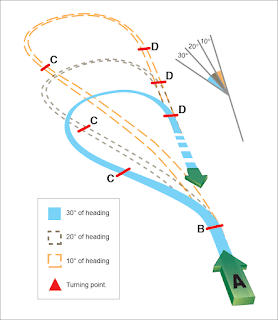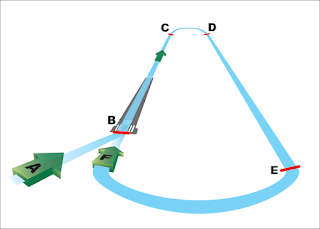Flight patterns are basic maneuvers, flown by sole reference to the instruments rather than outside visual clues, for the purpose of practicing basic attitude flying. The patterns simulate maneuvers encountered on instrument flights, such as holding patterns, procedure turns, and approaches. After attaining a reasonable degree of proficiency in basic maneuvers, apply these skills to the various combinations of individual maneuvers. The following practice flight patterns are directly applicable to operational instrument flying.
Racetrack Pattern
- Time 3 minutes straight-and-level flight from A to B. [Figure 1] During this interval, reduce airspeed to the holding speed appropriate for the aircraft.
- Start a 180° standard rate turn to the right at B. Rollout at C on the reciprocal of the heading originally used at A.
- Time a 1 minute straight-and-level flight from C to D.
- Start a 180° standard rate turn to the right at D, rollingout on the original heading.
- Fly 1 minute on the original heading, adjusting the outbound leg so that the inbound segment is 1 minute.
NOTE: This pattern is an exercise combining use of the clock with basic maneuvers.
 |
| Figure 1. Racetrack pattern (entire pattern in level flight) |
Procedure Turn
A procedure turn is a maneuver that facilitates:
- A reversal in flight direction.
- A descent from an initial approach fix or assigned altitude to a permissible altitude (usually the procedure turn altitude).
- An interception of the inbound course at a sufficient distance allowing the aircraft to become aligned with the final approach.
Procedure turn types include the 45° turn, the 80/260 turn, and the teardrop turn. All of these turns are normally conducted no more than 10 nautical miles (NM) from the primary airport. The procedure turn altitude generally provides a minimum of 1,000′ obstacle clearance in the procedure turn area (not necessarily within the 10 NM arc around the primary airport). Turns may have to be increased or decreased but should not exceed 30° of a bank angle.
Standard 45° Procedure Turn
- Start timing at point A (usually identified on approach procedures by a fix). For example, fly outbound on a heading of 360° for a given time (2 minutes, in this example). [Figure 2]
- After flying outbound for 2 minutes (point B), turn left 45° to a heading of 315° using a standard rate turn. After roll-out and stabilizing, fly this new heading of 315° for 40 seconds and the aircraft will be at the approximate position of C.
- At point C, turn 225° right (using a standard rate turn) which will provide a heading of 180°. The timing is such that in a no wind environment, the pilot will be aligned with the final approach course of 180° at D. Wind conditions, however must be considered during the execution of the procedure turn. Compensating for wind may result in changes to outbound time, procedure turn heading and/or time and minor changes in the inbound turn.
 |
| Figure 2. Standard procedure turn (entire pattern in level flight) |
80/260 Procedure Turn
- Start timing at point A (usually identified on approach procedures by a fix). For example, fly outbound on a heading of 360° for 2 minutes. [Figure 3]
- At B, enter a left standard rate turn of 80° to a heading of 280°.
- At the completion of the 80° turn to 280° (Point C), immediately turn right 260°, rolling-out on a heading of 180° (Point D) and also the reciprocal of the entry heading.
 |
| Figure 3. 80/260 procedure turn (entire pattern in level flight) |
Teardrop Patterns
There are three typical teardrop procedure turns. A 30°, 20°, and a 10° teardrop pattern. The below steps indicate actions for all three starting on a heading of 360°. [Figure 4]
 |
| Figure 4. Teardrop pattern (entire pattern in level flight) |
1. At point B (after stabilizing on the outbound course) turn left:
- 30° to a heading of 330° and time for 1 minute
- 20° to a heading of 340° and time for 2 minutes
- 10° to a heading of 350° and time for 3 minutes
2. After the appropriate time above (Point C), make a standard rate turn to the right for:
- 30° teardrop—210° to the final course heading of 180° (Point D)
- 20° teardrop—200° to the final course heading of 180° (Point D)
- 10° teardrop—190° to the final course heading of 180° (Point D)
By using the different teardrop patterns, a pilot is afforded the ability to manage time more efficiently. For instance, a 10° pattern for 3 minutes provides about three times the distance (and time) than a 30° pattern. Pattern selection should be based upon an individual assessment of the procedure turn requirements to include wind, complexity, the individual preparedness, etc.
Circling Approach Patterns
Pattern I
- At A, start timing for 2 minutes from A to B; reduce airspeed to approach speed. [Figure 5]
- At B, make a standard rate turn to the left for 45°.
- At the completion of the turn, time for 45 seconds to C.
- At C, turn to the original heading; fly 1 minute to D, lowering the landing gear and flaps.
- At D, turn right 180°, rolling-out at E on the reciprocal of the entry heading.
- At E, enter a 500 fpm rate descent. At the end of a 500 foot descent, enter a straight constant-airspeed climb, retracting gear and flaps.
Pattern II
Steps:
- At A, start timing for 2 minutes from A to B; reduce airspeed to approach speed. [Figure 6]
- At B, make a standard rate turn to the left for 45°.
- At the completion of the turn, time for 1 minute to C.
- At C, turn right for 180° to D; fly for 1-1/2 minutes to E, lowering the landing gear and flaps.
- At E, turn right for 180°, rolling-out at F.
- At F, enter a 500 fpm rate descent. At the end of a 500 foot descent, enter a straight constant-airspeed climb, retracting gear and flaps.
 |
| Figure 6. Circling approach pattern II (imaginary runway) |

